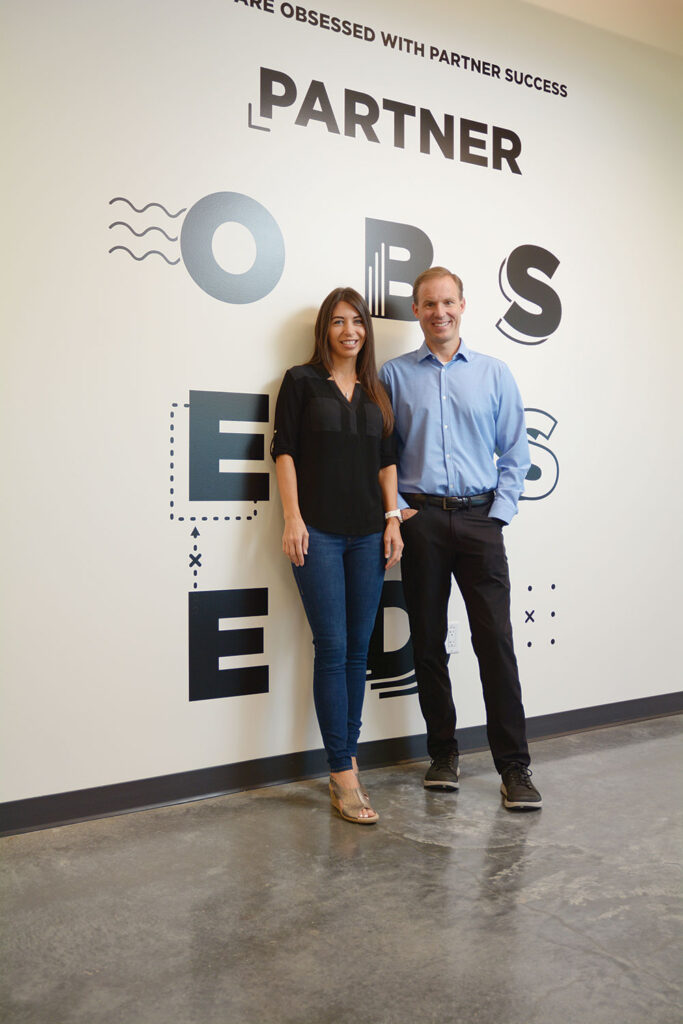Three-year growth 1,132%

WHEN DAVID WRIGHT AND MELANIE ALDER partnered on real estate projects a decade ago, their edge was in their Access database. They pulled foreclosure information before it hit the newspapers and then based their strategy on data. “With my background in data science, real estate is interesting, but honestly it’s not that fun,” Wright says. The two — who became Mr. and Mrs. five years into their venture — now get their kicks and giggles out of being obsessed with growing digital sales strategies for brand partners. They pull sales trends and data before it hits quarterly sales reports. Sense a Pattern? So do the hundreds of brands that turn to Lehi-based Pattern to utilize math to make business fun. And profitable. And multiplied.
I heard about a friend who sold $2 million of headbands on Amazon. I started putting together a business plan on how to help brands succeed. I knew enough math that I didn’t need to create a brand — I could help existing brands that are owned by creative types find success with e-commerce strategies. That was the business model. But it was only in my head.
Melanie and I had done real estate projects together, but I wasn’t ready to bring her into this idea. We had lunch at Cafe Rio and somehow she got out of me what I was working on and why I seemed less interested in properties lately. By the time we left that lunch, we were partners.
She’s a mover and a shaker. Within two weeks, we had the business entity up and running. By the time I finish a thought, Mel has it halfway done. We thought if we got things up and running, we would sell a ton of items for the brands we worked with.
We got our feet wet by designing a digital sales strategy for a magnetic poetry product with words you play with on the refrigerator. It was a disaster. We went five days with zero sales, and we wanted to quit. Then some random office in North Carolina bought 10 packages. And that was the lift that kept us going. But we’ve nearly quit quite a few times. Then we talk it through and discover a path forward. We figure out something new to measure and then pivot. Sometimes our most discouraging conversations end up with us being excited again.
Mel carried the company for the most part during the first two years. Pattern started in her office, and then her living room. I was still working full time for The Church of Jesus Christ of Latter-day Saints managing the church’s data and overseeing 125 employees. On the way home I would call Melanie and ask, “How did it go today?”
We started the business in January 2013 and got married in January 2018. It was a good move for me. Actually, I think it was a great move for both of us. Even this past weekend I was wondering, “How did I get her to marry me?”
In the beginning, I was the CEO and she was the COO — even though we don’t pay attention to titles. As the company grew, the COO role carried the heaviest weight. Mel was so busy. She woke up one morning and was like, “I don’t care about the shipping costs in Holland, but somebody needs to worry about that.” What she really wanted was to focus on strategy. That’s when she became the chief investment officer.
Being “partner-obsessed” is our No. 1 company value. We’re obsessed. Our No. 2 is data fanatics. Our edge is in the data. We use that to drive every decision we make as we grow brands. It’s exciting to run technology that delivers strong results. We geek out.
Our third value is that we’re a team of doers. We have a bias for action. We don’t know all the answers or have all the data, but we don’t wait until we do. We take action today.
Our fourth value is game-changers. We’re focused on continuing to evolve and stay the leader in this space by changing the game for brands in e-commerce. We win. We listen, we care and we politely call B.S. when we need to.
In November 2018, we rebranded from iServe to Pattern and moved into our offices at Innovation Point in Lehi. Our conference rooms are named after mathematicians.
We’ve partnered with many brands in the vitamin and supplement space. We partner with Panasonic. Pandora Jewelry. Skull Candy. Clorox. Nestle. And we just signed Igloo, so now we’ve got a bunch of coolers around here.
We have 100 employees in Utah and more outside of the United States, including two offices in China and another in Hong Kong. With our 350+ employees, we have the energy, time and data to manage e-commerce strategies. No brand is going to be as good on their own as we are at using technology to tweak strategies and uncover trends.
We have a bidding engine that makes 2 to 3 million bid changes a day. It’s not fuzzy math around here.
We’re projected to hit $330 million this year. Even if we don’t add any new brands, there’s no way we won’t hit a billion in four years just with the brands we have. We partner with companies that already have $10 million or more in current revenue. Our name fits our strategy. Our patterns work. It’s simple math.
We spent five days with zero sales, and we wanted to quit. Then some random office in North Carolina bought 10 packages.